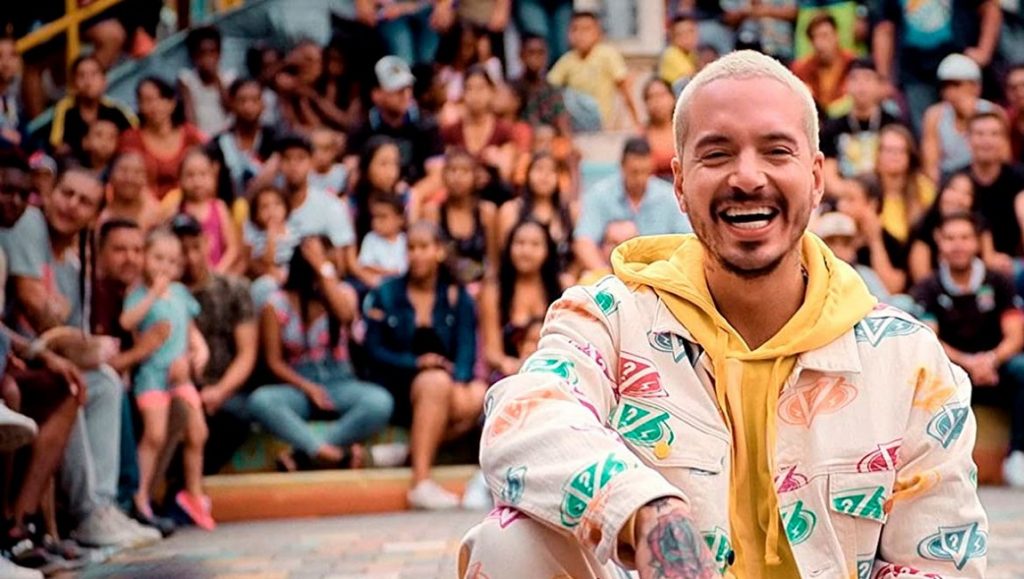The Boy from Medellín’s early commitment to emotional and psychological honesty is ultimately subsumed by the doc’s refusal to engage on any political level.
With its creeping bass line, its shuffling gait, and of course, J Balvin rolling his r’s through a wide, beaming smile, “Tranquila” — and its accompanying music video, set in Balvin’s hometown barrio — is not only one of the best reggaeton singles of the last 10 years from anywhere in the Latin American diaspora, but it’s also a pointed and geographically precise statement of purpose from an evolving, Colombian reggaeton, one that weaponizes the titular lyric (which means “relax” in English) by playing up both the sentiment behind it (Colombian music, notably cumbia, is known for more laid-back rhythms than those of neighboring Caribbean islands like Puerto Rico) while also locating an unmistakable and intentional aggression in Balvin’s syllabic-machine gun delivery — kill ‘em with kindness, so to speak. The song, along with the other singles from Balvin’s breakthrough album, 2013’s La Familia, arrived at a time when the big music labels were reorganizing and becoming more homogenized than ever (it was released on Capitol Latin, which had only recently been acquired from EMI during its expansive merger with Universal). Balvin’s music, though, represented a compelling hybridization of the local and global — which Matthew Heineman’s new biographical documentary takes care in establishing.
Born José Álvaro Osorio Balvín in Medellín, Colombia — originally living on the rich side of town but moving to the barrio after his father lost his job — Balvin wouldn’t adopt his stage name until after an exchange program that brought him to Oklahoma, a stint living with family in Staten Island, and a period of working (illegally) in Miami. When Balvin finally returned to Medellín to properly pursue his music career, at the age of 19, he did so already with a lot of accrued experience in a “global market” (he even studied international business for a few years at a university in Medellín). All this is to say that “Tranquila,” and the subsequent international superstardom that followed, was never a fluke; it was a carefully strived-toward goal that Balvin accomplished by learning the right tactics and applying them in ways beneficial to his career. There’s nothing wrong with that, of course, but it somewhat complicates one of the cornerstone claims of The Boy from Medellín: that of the staunch identification of Balvin with his hometown. Heineman’s documentary certainly acknowledges a variety of challenges to this claim from both artists who are still living and performing in the barrio and from some Colombian cultural commentators. But the narrative of these encounters, and of The Boy from Medellín overall, always feels shaped, very deliberately, by Balvin and his team, and not by any more impartial voices.
Whether at the direction of Heineman or the guidance of Balvin’s camp, or some combination of the two, The Boy from Medellín does manage to cover a lot of different territory — both that relating to Balvin’s own personal story and to the broader social context in which his fame and career exist. On the introspective end of that, there is a disarmingly frank discussion here about the anxiety and depression that first started afflicting Balvin in the early days of his career. Some of the ways in which this subject is addressed are far from novel for a “rock doc” — abusing pills, getting really fat — but others succeed in breaking through the common stigmas of mental illness and directly expressing just how unbearable life living with it can be, especially in specific, isolated moments that often provide no rational basis for the feeling. (As someone who has also admitted, in front of a camera, that he’s thought about killing himself, the moment here when Balvin says it, and the slight catch in his voice as he tries to get the words out — as if they’re some alien thing to expel from the body — is extremely moving.) What’s generally less successful about The Boy from Medellín is its attempts to grapple with certain intense political realities that Balvin is stubborn in his reluctance to confront. In particular, the 2019 protests in Colombia over the economic inequality fostered under Iván Duque Márquez’s government — and how Balvin’s lack of comment on the protests, especially as young people start losing their lives to the violent suppression efforts of the military police, threatens his reputation.
After the journalistic integrity that Heineman brought to documentaries on conflict like Cartel Land and City of Ghosts, the attempt here to equate the “hell” of those experiences with Balvin’s tortured decision about merely speaking on the protests and the violent response to them that is gripping his country seems like a rather ridiculous conflation of stakes. But even if one does choose to see Balvin’s chosen political affiliation as the make-or-break moment for his career that he seems to, asking viewers to sympathize with a stated desire to “remain impartial” and “out of politics,” in the wake of the sweeping political and social movements that have become an unavoidable reality in recent years, is a very big ask. And once the inevitable moment does come (after a painfully staged “speech” on the responsibility of celebrity given to a somber-looking Balvin by none other than fucking Scooter Braun) the subsequent giant stadium concert in Balvin’s Medellín that dominates the last section of the film — and to which everything has been nervously building, as the surrounding protests intensify — finds homogeneity ruling the day: Heineman’s The Boy from Medellín largely loses its cultural and psychological specificity, guiding Balvin’s embattled celebrity narrative to the same ecstatic catharsis familiar from any number of made-to-order music documentaries.
You can currently stream Matthew Heineman’s The Boy from Medellín on Amazon.


Comments are closed.